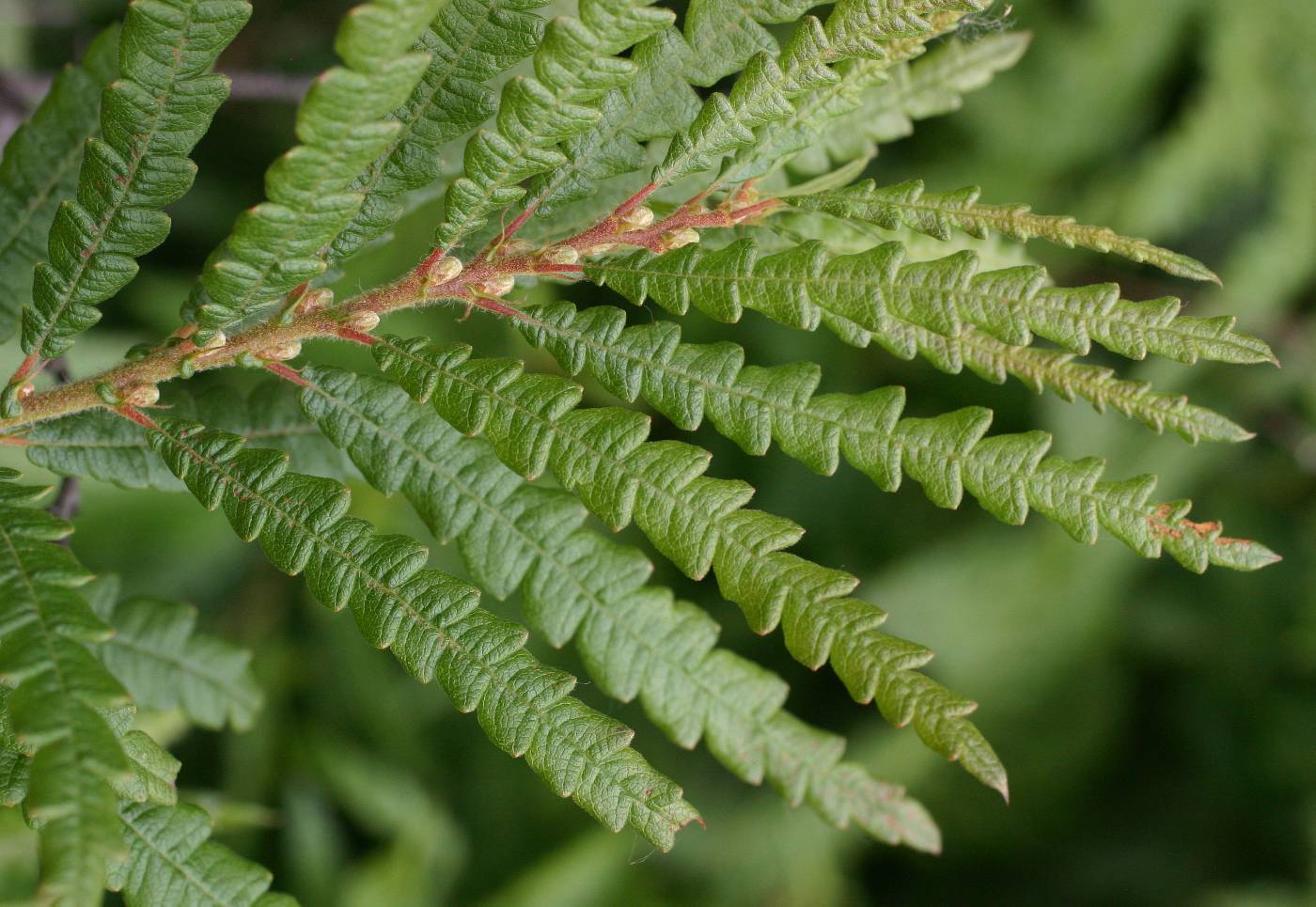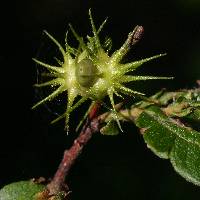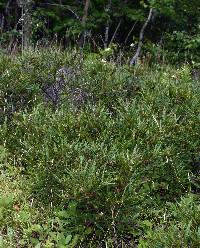|
|
|
|
Family: Myricaceae
sweet fern
[Comptonia peregrina var. aspleniifolia (L.) Fernald, moreMyrica aspleniifolia L., Myrica aspleniifolia var. tomentosa (A. Chev) Gleason, Myrica peregrina (L.) Kuntze] |
Shrubs , to 1.5 m, forming rhizomatous colonies. Branchlets red-brown to gray, pilose to villose, sometimes puberulent. Leaves: stipules nearly cordate, long-acuminate. Leaf blade very aromatic when crushed, 3-15.5 × 0.3-2.9 cm, lobes alternate to nearly opposite, base truncate, cuneate to attenuate, or oblique, apex acute; surfaces abaxially pale gray-green, densely pilose to puberulent, adaxially dark green, densely pilose to glabrate, gland-dotted, especially adaxially. Inflorescences: staminate in clusters at ends of branches, elongating to 5 cm, bracts broadly ovate to trullate, margins ciliate, apex acute to long-acuminate, abaxially gland-dotted; pistillate to 5 mm at anthesis, elongating in fruit to 2 cm, bracteoles to 1.3 cm, pilose, gland-dotted. Fruits 2.5-5.5 mm. Flowering spring, fruiting summer. Dry, sterile, sandy to rocky soils in pinelands or pine barrens, clearings, or edges of woodlots; 0-1800 m; N.B., N.S., Ont., P.E.I., Que.; Conn., Del., Ga., Ill., Ind., Ky., Maine, Md., Mass., Mich., Minn., N.H., N.J., N.Y., N.C., Ohio, Pa., R.I., S.C., Vt., Va., W.Va., Wis. Comptonia peregrina has been reported from Tennessee (Scott County), but I have not seen any specimens. Many Native American tribes used different parts of Comptonia peregrina variously: as an incense for ritual ceremonies; for medicinal purposes; as a stimulant or tonic; as a food seasoning; and as a poison (D. A. Moerman 1986).
Shrub to 1.5 m tall Leaves: alternate, dark green and often shiny above, grayish green beneath, 3 - 15.5 cm long, 0.3 - 2.9 cm wide, linear, fern-like (pinnatifid), dotted with fragrant glands, somewhat hairy beneath, persisting into winter. Flowers: either male or female, found on the same tree (monoecious) or on separate trees (dioecious). Male flowers are borne in yellowish green cylindrical catkins 1.5 - 4 cm long clustered at the ends of branches. Female flowers borne in spherical to elongated catkins 5 - 7 mm long, with 8 persistent, reddish, linear bracts at the base. Fruit: an achene, 3 - 5 mm long, olive-brown, elliptical to conical, surrounded by bur-like bracts 1 - 2 cm long. Twigs: yellowish green to reddish brown with resin dots when young, becoming yellowish brown and shiny and finally reddish purple to copper. Buds: tiny, round, and hairy. Similar species: Comptonia peregrina is a spreading shrub with fern-like, aromatic leaves and bur-like achenes that make it distinctive in the Chicago Region. Flowering: April Habitat and ecology: Forms colonies by spreading rhizomes in sand flats and barrens or other areas with infertile, sandy or gravelly soils. Occurence in the Chicago region: native Notes: This is a good plant to use along highways or other sandy, dry, infertile areas. It tolerates infertile soil because nitrogen-fixing bacteria form nodules in the roots, which convert atmospheric nitrogen to a form that the plant can use. Native Americans once used this species as a tonic, stimulant, ceremonial incense, or poison. The leaves can be used as a mosquito repellent when crushed or burned. Etymology: Comptonia is named after Henry Compton (1632 - 1713), a patron of botany and bishop of London. Peregrina comes from the Latin word meaning exotic, which refers to the species being foreign to the original European author. Author: The Morton Arboretum Dioecious or seldom monoecious, much branched shrub to 1.5 m; terminal bud wanting; lvs linear-oblong, 6-12 נ0.8-1.5 cm, deeply pinnately lobed; staminate catkins clustered near the tips of the twigs, arising directly from the distal axillary buds, cylindric, mostly 1.5-4 cm, nodding, their bracts ±quadrangular, acuminate; anthers formed in the fall; pistillate catkins subglobose, at maturity forming a bur 1-2 cm thick; achene ellipsoid-conic or subcylindric, 3-5 mm; 2n=32. Dry, often barren and sandy soil; N.Y. to N.C., w. S.C., and n. Ga., w. to Sask., Minn., Ill., and Tenn. Mar.-June. (Myrica asplenifolia) Gleason, Henry A. & Cronquist, Arthur J. 1991. Manual of vascular plants of northeastern United States and adjacent Canada. lxxv + 910 pp. ©The New York Botanical Garden. All rights reserved. Used by permission. |




